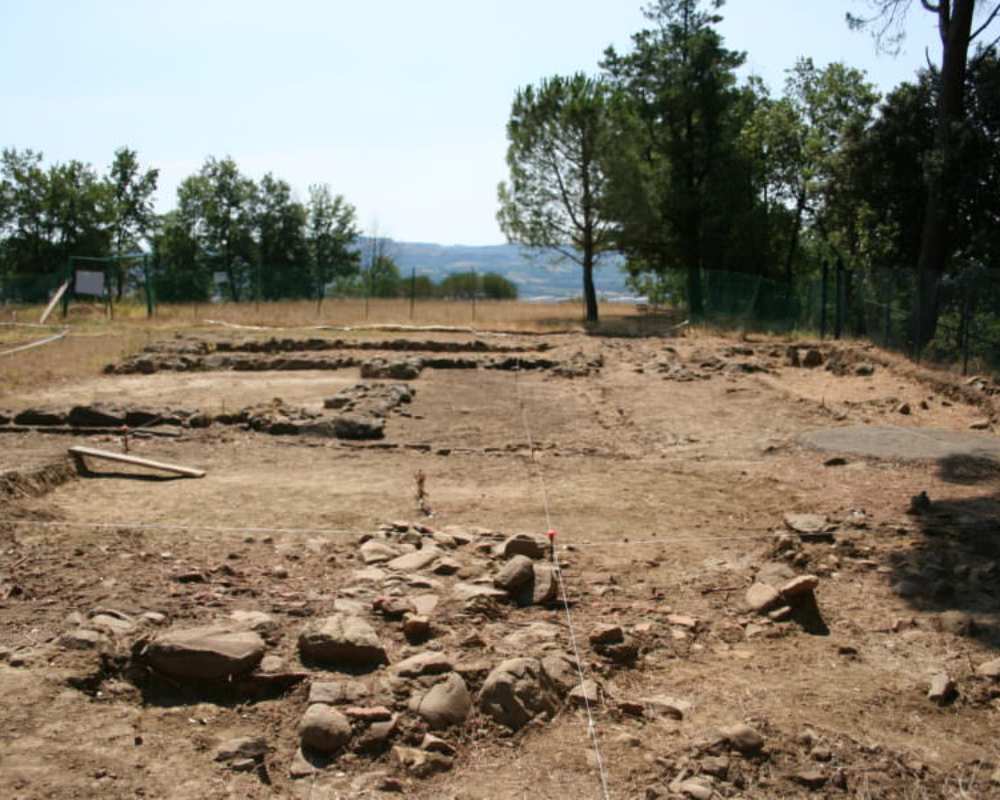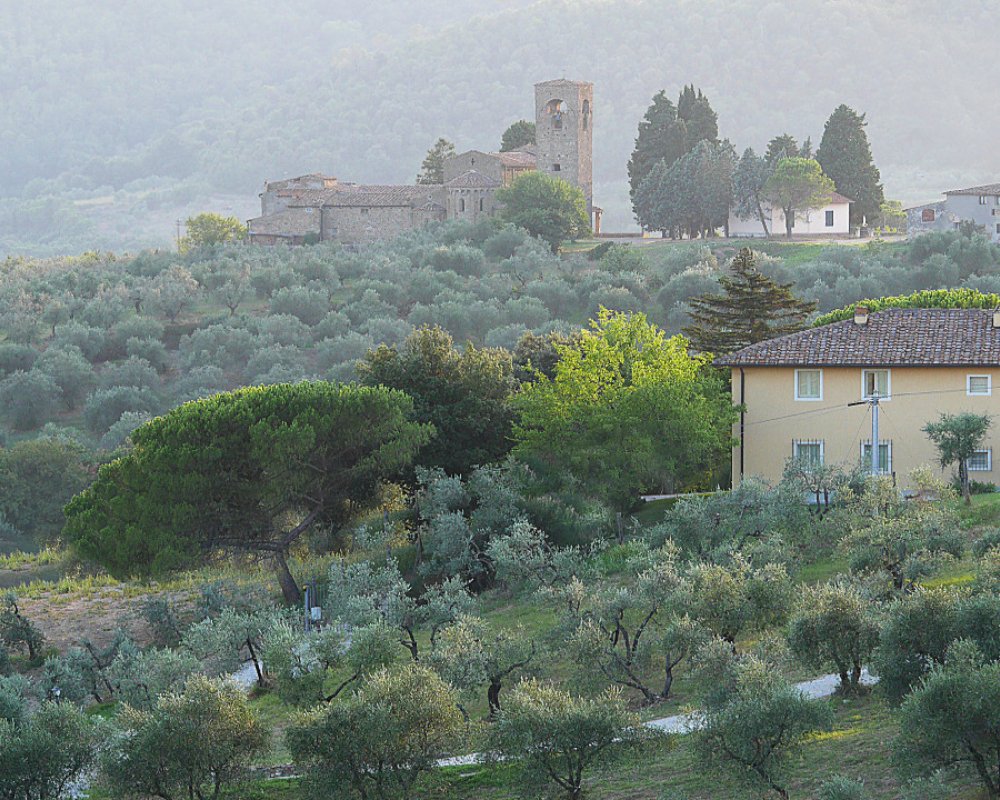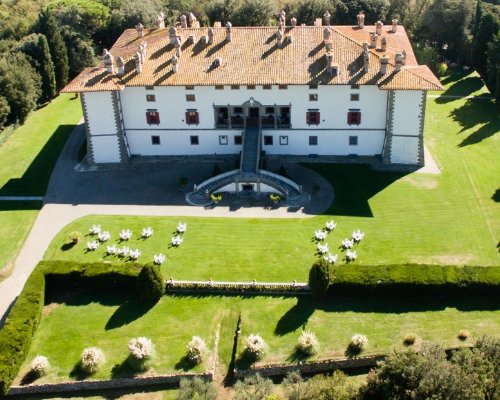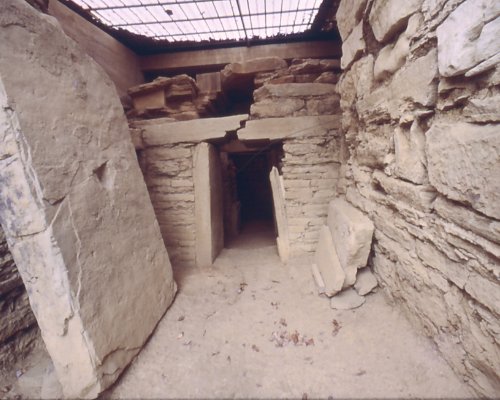A historical itinerary from Artimino to Vinci, with visits to Carmignano and Comeana
The Etruscan towns near Montalbano have always vaunted favourable positions for commercial exchanges, with Artimino standing out thanks to its millennia of history and artistic production. Their locations, in the foothills of Monte Albano, were idea for watching over the traffic from the port in Pisa to the Arno flood plain, which around this area would change route to head towards inland Etruria (Volterra, Chiusi).
Artistic production in these towns was influenced on the one hand by the workshops in Fiesole and on the other by the shops in Volterra: these included pietra serena stele statues with bas-reliefs as well as, in the late Hellenistic period, small alabaster urns, similar to what was found in Volterra.
This itinerary on the slopes of Montalbano offers a discovery of the tombs of Comeana, Boschetti and Montefortini, as well as the tomb of the noble warrior of Prato Rosello. In some of these, jewellery and ivory grave goods were discovered, in addition to elegant ceramics. In some cases, their monumental structures, which commemorated rich owners, are still well-preserved and covered by the characteristic mound of earth.
The itinerary begins in Artimino with a visit to the Archeological Museum and the town. The castle in Artimino, first mentioned in 1026 and still partly visible, played a fundamental role in the Middle Ages in the conflict between Pistoia and Florence over control of the territory.
Let’s leave the fortified village behind and head towards the Medici Villa La Ferdinanda. The villa was built in four years (1596-1600) at the behest of Grand Duke Ferdinand I de’ Medici. The design was the work of Bernardo Buontalenti, who was able to combine the architectural elements found in the other Medici villas into this one single building.
Once in front of the villa, let’s head down to the right along via del Palazzone to reach an open space with a tourist info pole; park the car and continue on foot towards the Etruscan necropolis of Prato Rosello, taking the trail through the Mediterranean scrub.
The fork in the road connecting the area round the Medici villa to the Arno has been used since the 8th century as a funerary zone. Archeological excavations have brought to light five tombs that each vaunt a different architectural structure as well as grave goods and burials not related to the monumental structures.
After visiting the necropolis, let’s go back the way we came from to grab the car and return towards the villa. Passing by the Medici residence, we’ll continue down to the right to Comeana, along via Lazzera, to visit the tombs of Montefortini and Boschetti.
The itinerary begins in Artimino with a visit to the Archeological Museum and the town. The castle in Artimino, first mentioned in 1026 and still partly visible, played a fundamental role in the Middle Ages in the conflict between Pistoia and Florence over control of the territory.
Let’s leave the fortified village behind and head towards the Medici Villa La Ferdinanda. The villa was built in four years (1596-1600) at the behest of Grand Duke Ferdinand I de’ Medici. The design was the work of Bernardo Buontalenti, who was able to combine the architectural elements found in the other Medici villas into this one single building.
Once in front of the villa, let’s head down to the right along via del Palazzone to reach an open space with a tourist info pole; park the car and continue on foot towards the Etruscan necropolis of Prato Rosello, taking the trail through the Mediterranean scrub.
The fork in the road connecting the area round the Medici villa to the Arno has been used since the 8th century as a funerary zone. Archeological excavations have brought to light five tombs that each vaunt a different architectural structure as well as grave goods and burials not related to the monumental structures.
After visiting the necropolis, let’s go back the way we came from to grab the car and return towards the villa. Passing by the Medici residence, we’ll continue down to the right to Comeana, along via Lazzera, to visit the tombs of Montefortini and Boschetti.
The majestic Montefortini tomb (currently 12 metres tall) conserves two funerary structures inside. The oldest (640-630 BCE) is a beehive tomb (covered with a false dome 7 metres wide) with a central pillar and long entrance corridor.
The extraordinary grave goods, on display at the museum in Artimino, include ivory objects sculpted, engraved and traced, as well as an incredible turquoise glass cup, crockery and two censers.
Shorty after the tomb was built, part of the dome collapsed and the structure was enlarged, while another tomb was built with a monumental corridor 13 metres long. The grave goods in this tomb must also have been quite a treasure, even if little has survived to today, including bucchero vases, small ivory plates, an Egyptian unguentarium, bronze objects and gold fibulae.
Nearby, the Boschetti tomb, damaged by many years of agricultural work, conserves its vestibule and cell, constructed with large, jointed slabs of sandstone. The grave goods of both tombs are on display at the Museum in Artimino.
The majestic Montefortini tomb (currently 12 metres tall) conserves two funerary structures inside. The oldest (640-630 BCE) is a beehive tomb (covered with a false dome 7 metres wide) with a central pillar and long entrance corridor.
The extraordinary grave goods, on display at the museum in Artimino, include ivory objects sculpted, engraved and traced, as well as an incredible turquoise glass cup, crockery and two censers.
Shorty after the tomb was built, part of the dome collapsed and the structure was enlarged, while another tomb was built with a monumental corridor 13 metres long. The grave goods in this tomb must also have been quite a treasure, even if little has survived to today, including bucchero vases, small ivory plates, an Egyptian unguentarium, bronze objects and gold fibulae.
Nearby, the Boschetti tomb, damaged by many years of agricultural work, conserves its vestibule and cell, constructed with large, jointed slabs of sandstone. The grave goods of both tombs are on display at the Museum in Artimino.
From Comeana, we next head to Carmignano to admire the Visitation, a masterpiece of Tuscan Mannerism by Pontormo (1494-1557), conserved in the Parish Church of S. Michele e S. Francesco. The oil painting dates to 1529 and depicts the meeting between Mary and her sister, Elizabeth, both pregnant.
After Carmignano, let’s travel the Provinciale n.10 of Pietramarina until we’re near the Church of San Giusto.
We’ll park the car here and climb up the paved road, following the directions; fortunately cars are not allowed on this road, so we won’t have to contend with those! A panoramic trail winds uphill to the top of Monte Pietramarina. In this area, we find the Masso del Diavolo, close to the archeological area.
The top of the hill was frequented by Etruscans starting in the 7th century BCE. Excavations have brought to light a defense wall that encircled the settlement and other buildings still being dug out. The site must have been used for watching over the lower Valdarno, and considering its elevated and dominating position, allowed the Etruscans to communicate with other cities like Fiesole, Volterra and Artimino, as well as with the coast (on clear days, you can see all the way to Livorno).
From here, we can take via Castra to reach Limite, followed by Vinci.
From Comeana, we next head to Carmignano to admire the Visitation, a masterpiece of Tuscan Mannerism by Pontormo (1494-1557), conserved in the Parish Church of S. Michele e S. Francesco. The oil painting dates to 1529 and depicts the meeting between Mary and her sister, Elizabeth, both pregnant.
After Carmignano, let’s travel the Provinciale n.10 of Pietramarina until we’re near the Church of San Giusto.
We’ll park the car here and climb up the paved road, following the directions; fortunately cars are not allowed on this road, so we won’t have to contend with those! A panoramic trail winds uphill to the top of Monte Pietramarina. In this area, we find the Masso del Diavolo, close to the archeological area.
The top of the hill was frequented by Etruscans starting in the 7th century BCE. Excavations have brought to light a defense wall that encircled the settlement and other buildings still being dug out. The site must have been used for watching over the lower Valdarno, and considering its elevated and dominating position, allowed the Etruscans to communicate with other cities like Fiesole, Volterra and Artimino, as well as with the coast (on clear days, you can see all the way to Livorno).
From here, we can take via Castra to reach Limite, followed by Vinci.
In Vinci, we can admire the town and landscape, as well as visit the Leonardo Museum, housed within the medieval walls, in the castle of the Guidi Counts (11th-12th century). The museum conserves one of the largest and original collections of machines and models designed by Leonardo, a technologist, scientist and engineer, all of which have been rebuilt based on the master’s drawings. Leonardo’s birthplace is also interesting to see.
In Vinci, we can admire the town and landscape, as well as visit the Leonardo Museum, housed within the medieval walls, in the castle of the Guidi Counts (11th-12th century). The museum conserves one of the largest and original collections of machines and models designed by Leonardo, a technologist, scientist and engineer, all of which have been rebuilt based on the master’s drawings. Leonardo’s birthplace is also interesting to see.
In the surrounding area

If you are still itching to learn more, you can visit the other towns and museums dedicated to the Etruscan civilization.
The museum in Larciano Castello, for example, is home to objects coming from occasional discoveries in various places in the Valdinievole.
The museum in Fucecchio, located in the historic Palazzo Corsini, vaunts an archeological section that documents some aspects of the history of the settlements in the area.
The archeological museum in Montelupo Fiorentino boasts a collection of objects coming from the La Falsettaia necropolis and the town of Montereggi.
The excavations begun in 1965 around Capraia e Limite led to the creation of the Montereggi Archeological Park, which vaunts artefacts that attest to the ancient civilizations that once lived on the banks of the Arno, including the Etruscans, who settled here from the 5th to 1st centuries BCE.


